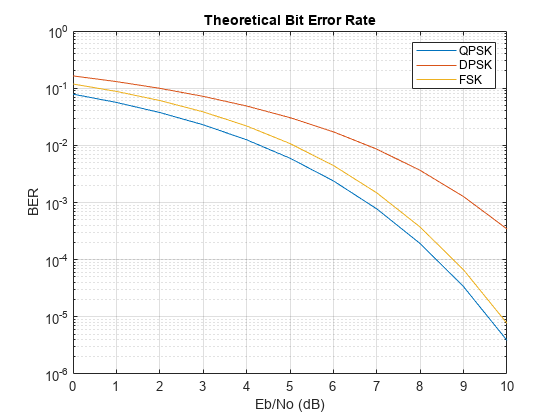berawgn
BER and SER for uncoded data over AWGN channels
Syntax
Description
The berawgn function returns the bit error rate (BER)
and symbol error rate (SER) in an additive white Gaussian noise (AWGN) channel for
uncoded data using various modulation schemes. The first input argument,
EbNo, is the ratio of bit energy to noise power spectral
density in dB
(Eb/N0).
Values in the output ber and ser vectors
correspond to the theoretical error rate at the specified
Eb/N0
levels for a Gray-coded signal constellation. For more information, see Analytical Expressions Used in berawgn Function and Bit Error Rate Analysis App.
Examples
Input Arguments
Output Arguments
Limitations
The numerical accuracy of the output returned by this function is limited by approximations related to the numerical implementation of the expressions to roughly two significant digits.
Alternatives
You can configure the Theoretical tab in the Bit
Error Rate Analysis app to compute theoretical BER values instead of using the
berawgn function.
References
[1] Anderson, John B., Tor Aulin, and Carl-Erik Sundberg. Digital Phase Modulation. New York: Plenum Press, 1986.
[2] Cho, K., and D. Yoon. "On the General BER Expression of One- and Two-Dimensional Amplitude Modulations." IEEE® Trans. Commun. 50, no. 7 (2002): 1074-80.
[3] Lee, P. J. "Computation of the Bit Error Rate of Coherent M-ary PSK with Gray Code Bit Mapping." IEEE Trans. Commun. 34, no. 5 (1986): 488-91.
[4] Proakis, John G. Digital Communications. 5th ed. New York: McGraw Hill, 2007.
[5] Simon, M. K, S. M. Hinedi, and W. C. Lindsey. Digital Communication Techniques – Signal Design and Detection. Prentice-Hall, 1995.
[6] Simon, M. K. "On the Bit-Error Probability of Differentially Encoded QPSK and Offset QPSK in the Presence of Carrier Synchronization." IEEE Trans. Commun. 54, (2006): 806-12.
[7] Lindsey, W. C., and M. K. Simon. Telecommunication Systems Engineering. Englewood Cliffs, N.J: Prentice-Hall, 1973.
Version History
Introduced before R2006a
